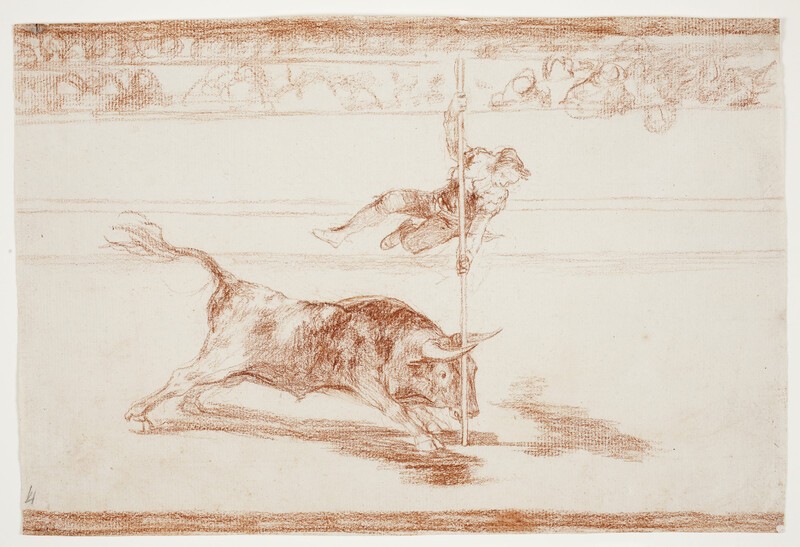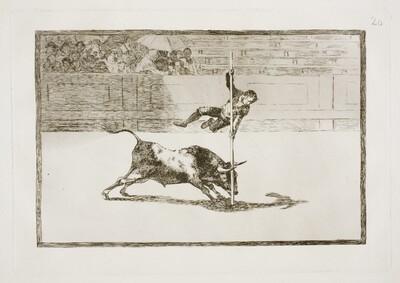- Cronología
- Ca. 1814 - 1816
- Ubicación
- The Prado National Museum. Madrid, Madrid, Spain
- Dimensiones
- 186 x 278 mm
- Técnica y soporte
- Sanguine on laid paper
- Reconocimiento de la autoría de Goya
- Documented work
- Titular
- El Prado National Museum
- Ficha: realización/revisión
- 02 Oct 2021 / 22 Jun 2023
- Inventario
- (D4307)
4 (in pencil, lower left corner)
See How the ancient Spaniards hunted bulls on horseback in the countryside.
This preparatory drawing passed by inheritance in 1828 to Javier Goya, the painter's son, and in 1854 to Mariano Goya y Goicoechea, the artist's grandson. It was subsequently owned by Valentín Carderera (ca. 1861) and Mariano Carderera (1880). In 1886 it was acquired from Mariano Carderera, along with many other drawings by Goya, including almost all the preparatory studies for the Bullfight, by the Directorate General of Public Instruction, and was assigned to the Prado Museum, where it entered on 12 November 1886.
See How the ancient Spaniards hunted bulls on horseback in the countryside.
Preparatory drawing of the print Juanito Apiñani's lightness and daring in the one in Madrid. In this preparatory study, Goya was able to masterfully capture that stiflingly hot afternoon in the Madrid bullring in which Juanito Apiñani performed a pole vault across a bull. In the drawing, the contrast between the bull, the intensity of the line, which matches the brute force of the animal charging against the pole, and the graceful lightness of the man suspended for a moment in the air, is striking.
There are elements that differ from the engraving, the main one being that the bullring still has spectators on all sides, whereas in the print they are all huddled to one side. The characteristic parasols present in the engraving are not yet visible either. Nonetheless, many of the features of the print, such as the very short shadows on the bright sand, are already present here.
It should be noted that the drawing is notable for the casualness of its strokes, which allow the movement to be intuited despite the speed of its execution. Like the print it is used as a starting point, the drawing resembles a photograph: it manages to capture the moment as if it were a snapshot.
-
Goya. Gemälde Zeichnungen. Graphik. TapisserienKunsthalle BaselBasle1953from January 23th to April 12th 1953cat. 112
-
Goya. Drawings, Etchings and LithographsGoya. DrawingsLondon1954from June 12th to July 25th 1954cat. 67
-
cat. 48
-
cat. 48
-
cat. 48
-
cat. 48
-
cat. 48
-
Los dibujos de GoyaMuseo Provincial de ZaragozaZaragoza1978exhibition organized by Museo Provincial de Zaragoza, Ministerio de Cultura and Ayuntamiento de Zaragoza, exhibition guide written by Miguel Beltrán Lloris and Micaela Pérez Sáenz. October 1978pp. 36-37, cat. 86
-
Goya: Zeichnungen und DruckgraphikStädtische Galerie im Städelschen KunstintitutFrankfurt1981from February 13th to April 5th 1981
-
Madrid2002
-
Madrid2007
-
Madrid2019cat. 199
-
1946pp. 177-216, espec. p. 199
-
MadridMuseo del Prado1954n. 173
-
1961pp. 120-127
-
ParísLe Club Français du Livre1963p. 100
-
Vie et ouvre de Francisco de GoyaParísOffice du livre1970p. 278, cat. 1191
-
Barcelona1974p. 15
-
Dibujos de Goya, 2 volsBarcelonaNoguer1975pp. 374-375, cat. 262
-
El mundo de Goya en sus dibujosMadridUrbión1979pp. 196-197
-
MadridMuseo Nacional del Prado2001pp. 74-76
-
MadridMuseo Nacional del Prado2019p. 300-301

